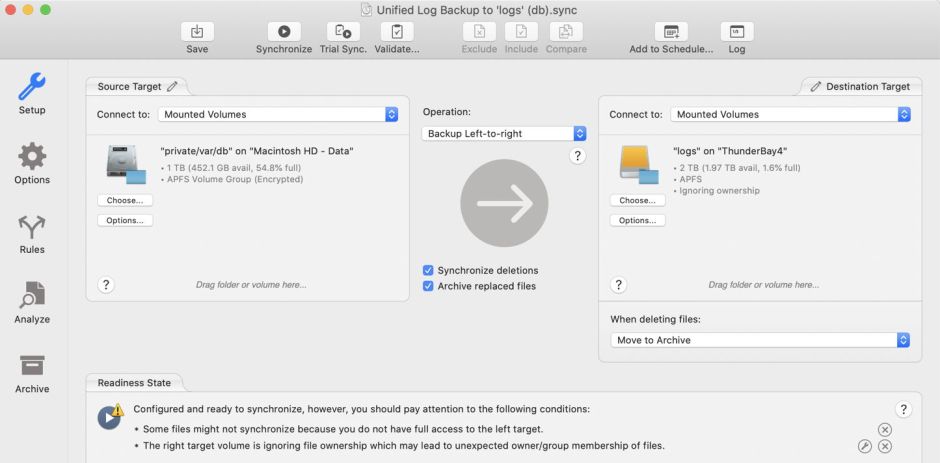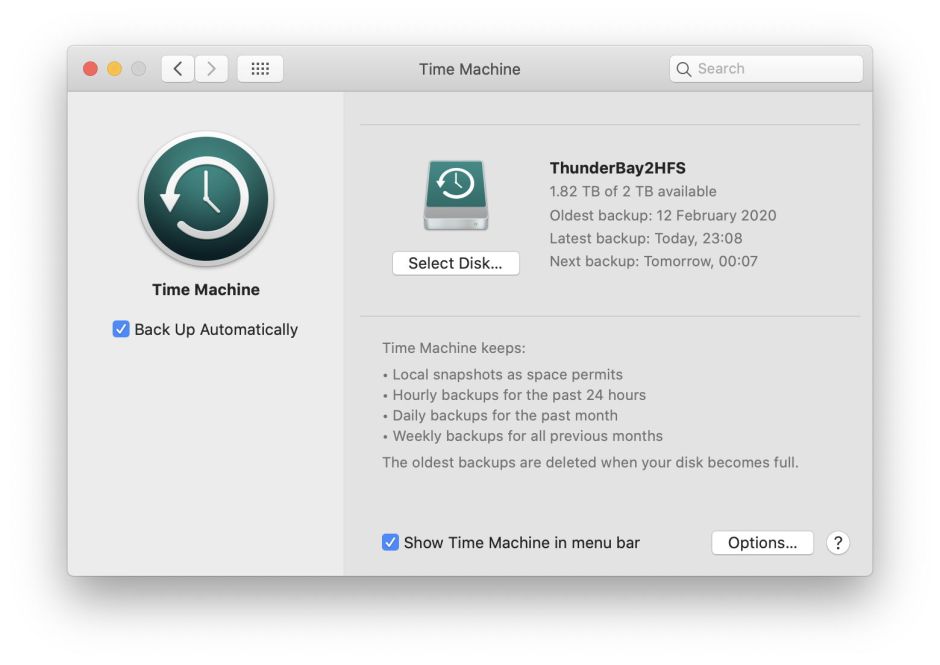In the previous two episodes, I have explained how I decided what I needed to back up and how often, and described how I put Carbon Copy Cloner to use making daily backups of my Catalina Data volume and an external working volume. That takes care of the first two of my requirements:
- a non-bootable copy of the System volume after each update to macOS, for reference (actually bootable, using CCC);
- a full copy of my Data volume and its external supplement, updated nightly (using CCC);
- a full copy of my ~/Documents folder updated hourly;
- a full copy of my main working folder on an external SSD updated hourly;
- a Time Machine backup of that same working folder every hour.
Chronosync
For the last three requirements, I want utilities which will back up changed files in my most active and critical folders every hour. These backups bridge the gap between saved versions (where available) and daily full backups. There’s no shortage of fine apps which I could have chosen, and after careful shopping around, I selected ChronoSync. You’ll no doubt have your own favourite, but I have been very impressed by this modestly-priced app which is fully compatible with Catalina, has some of the most detailed release notes you’ll come across, and most important of all is sold as a conventional lifetime licence.
ChronoSync must be one of the most flexible backup utilities available, but doesn’t force you to negotiate windows full of cryptic options: it offers a whole suite of setup assistants to guide you through creating synchronisation and backup tasks, and for modifying existing tasks. These range from simple options such as backing up a Home folder through to making one backup of multiple folders. In this example, I’m going to step through the latter for my sixth backup task, the one that I hadn’t reckoned with when I first drew up my requirements.
As I’ve been evolving my list of needs, I realised that I also wanted to keep, as long as I can, old unified log files from /var/db/diagnostics and /var/db/uuidtext, so that I could turn them into a logarchive and access logs from weeks or even months ago. This turns out to be simple to accomplish in ChronoSync.

The first steps are to select those two folders as the source, then select a destination.

For these active folders, I want ChronoSync to maintain an archive, into which it moves files which are deleted from or replaced in the backup source. The next step sets that as the behaviour.


This is all you need to create a backup task, and can now run it as a test, perform fine tuning, and schedule it to be run automatically.

I then clicked on the Synchronize button to run the first test backup, which copied across just under 2,000 files, a little more than 1 GB, in 8.5 seconds. I looked carefully at the structure and contents of the backup created by ChronoSync, and decided that’s just what I want.
It’s then time to schedule the task. In this case, with log files, I want this to run once a day, early in the morning, once CCC has run its daily backups.

Once I had added backup tasks to cover items 3 and 4 in my list of requirements, and the new item 6 for logs, I then left them running for a few days, keeping a watchful eye on what was getting backed up, how free space on the backup volume was changing, and most importantly whether ChronoSync was able to run these hourly incremental backups without having any noticeable effect on my use of the Mac.

I’m delighted with this backup strategy now, and happy that ChronoSync is an excellent tool for the job.

Every hour, my two most active folders get backed up, and every day my logs get backed up as well.
Time Machine
The problems I had experienced with Time Machine related to it trying to make whole-volume backups, including the hidden versions database. I still think that Time Machine has an important role to play in backing up key folders, and if that proves too slow on the first full backup you can always add the versions database to its list of exclusions. In my backup strategy, it provides an alternative method and medium for backups of my external working folder.
To do that, I added all other volumes to its exclude list, then all other folders on that external disk. One neat trick you can use is to add all the folders first, then select the one(s) that you want to back up and click on the – tool to remove it from the exclude list.

Unfortunately the Time Machine pane doesn’t provide a particularly convenient interface for such long and complex exclude lists, but you should only have to do this once.

Once automatic backups are enabled, you can then monitor progress of the first full backup in the pane, and perhaps using T2M2’s Check Speed button should you start getting worried.
That completes all my on-site backups. To recap, these now consist of:
- a copy of the System volume after each update to macOS, for reference (incidentally bootable, using CCC to its own volume on SSD 4);
- a full copy of my Data volume and its external supplement, updated nightly (using CCC to SSD 1);
- a full copy of my unified log files, updated nightly (using ChronoSync to SSD 3);
- a full copy of my ~/Documents folder updated hourly (using ChronoSync to SSD 3);
- a full copy of my main working folder on an external SSD updated hourly (using ChronoSync to SSD 4);
- a Time Machine backup of that same working folder every hour (to SSD 2, HFS+ format).
This spreads the risk so that single SSD failure should never be a disaster, and spreads the wear on those four SSDs so that none should run out of lifetime in the next five or six years – an important consideration when using SSDs. Although I haven’t yet tested a full restore of my Mac from my new backup system, restoring individual files and folders is very straightforward and appears completely reliable. I can’t see any drawbacks, can you?
My next task is to look at off-site backups.

